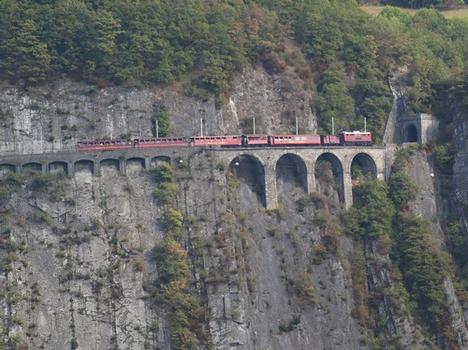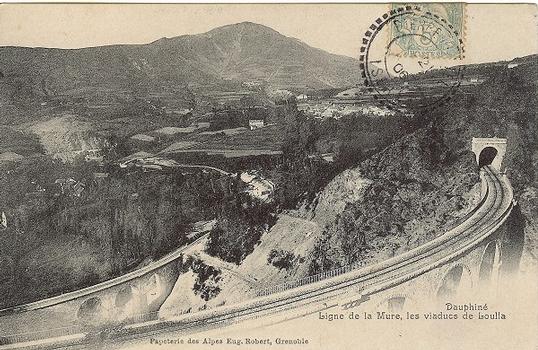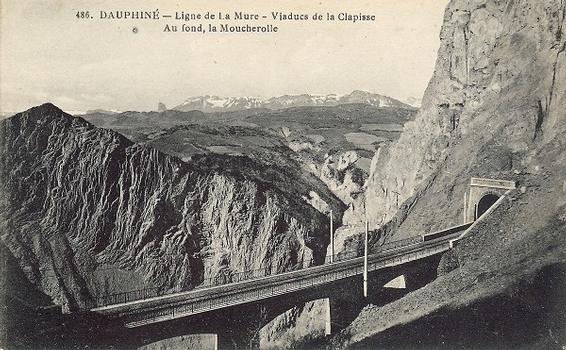General Information
Project Type
| Function / usage: |
Railroad (railway) line |
|---|
Location
| km | Name |
Technical Information
Dimensions
| length | 30.1 km | |
| underground length | 4 256 m | |
| number of bridges | 7 | |
| number of tunnels | 18 |
Chronology
| 1 August 1888 | The line is put into service. |
|---|
Excerpt from Wikipedia
The Chemin de Fer de La Mure (La Mure railway) is a former coal-carrying electrified railway in (and owned by) the Department of Isère near the city of Grenoble, France, which lost ist regular public passenger service from 2 February 1950 (although miners' trains continued until autumn 1962). It lost most of ist freight traffic – apart from anthracite coal – in 1952, and even the anthracite ceased from 18 October 1988. However, the local tourist office had been chartering seasonal tourist passenger trains from 8 September 1968 and these developed steadily over the years, the line becoming one of the finest tourist railways in Europe with views over dams and lakes, and mountain scenery. Since 1 February 1998 the concession to operate the line and ist tourist trains has been held by CFTA, now Veolia. The line can be reached easily by road from Grenoble, or by trains on the SNCF line towards Gap.
On October 26, 2010, shortly before the end of the season, a landslide destroyed the Viaduc de la Clapisse and parts of a tunnel entrance. In June 2017, the General Council of the Department of Isère announced that the company Edeis had been chosen to repair the railway and take over ist operation, with the aim of having it operational again for the 2020 season.
History
The line was built between 1882 and 1886, to link Saint-Georges-de-Commiers and La Mure through a mountainous region of the department of Isère.
The 30-kilometre (19 mi) long, metre gauge line runs from La Motte-d'Aveillans and La Mure to a connection with the main line of the PLM railway at Saint-Georges-de-Commiers. The line was almost closed in the mid-1970s and if the country hadn't been suffering an oil crisis the line would have met ist end. Ist life was extended by fifteen years, which proved to be ist saviour. Unlike many other lines this became a tourist attraction which combines an area of industrial heritage with some of the finest scenery on any similar line on the continent.
The railway was electrified in 1903, using a symmetrical current power supply with two overhead lines at plus and minus 1200 volts direct current respectively. In 1950, this non-standard system was replaced with a conventional power supply with a single overhead line at 2400 volts direct current. The branch line between La Mure and Corps was opened in 1932 and closed for passenger traffic in 1952.
Coal traffic ceased in 1988, and most of the coal installations were demolished, the coal being transported by road. The Matheysine coalmines were finally closed on March 28, 1997. The SGLM found a new vocation in providing a tourist attraction and as a result, there remain all of the line's historical installations, the workshops, forge, joinery shop, etc. The network's departure and arrival stations were dependent on connections with the PLM railway's Grenoble–Veynes line. The necessary facilities together with the transshipment platform for the automatic transfer of the coal from the SGLM coal cars to the trains operated by PLM (which became SNCF in 1938) were built adjacent to the PLM station, today the station for the Chemin de fer de La Mure.
When they last operated, the trains of the railway ran at the leisurely pace of up to 30 km/h.
Text imported from Wikipedia article "Chemin de fer de La Mure" and modified on February 21, 2022 according to the CC-BY-SA 4.0 International license.
Participants
Relevant Web Sites
Relevant Publications
- (1978): Petite histoire du chemin de fer de montagne de Saint-Georges-de-Commiers à La Mure. Premier train électrifié de France. Merveille du Dauphiné. Imprimerie Léostic, Seyssinet-Pariset (France), pp. 158.
- About this
data sheet - Structure-ID
10000831 - Published on:
10/01/2006 - Last updated on:
28/05/2021










